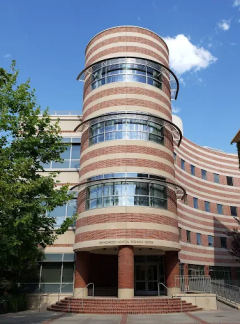Research
Research at the Department of Orthopaedic Surgery

In 2007, the UCLA/Orthopaedic Hospital (now Luskin Orthopaedic Institute for Children) Department of Orthopaedic Surgery opened the Cesar Pelli-designed, state-of-the-art 35,000 square foot Orthopaedic Hospital Research Center (OHRC) in the heart of the Court of the Sciences on the UCLA Westwood campus (left). Addition of the OHRC catapulted the UCLA Department of Orthopaedic laboratory research space to more than 48,000 square feet, surpassing most other departments of orthopaedic surgery in the United States.
The OHRC, along with affiliated research space in the MacDonald Research Laboratory and the UCLA Westwood Rehabilitation Center, is currently home to 21 faculty. Many former trainees have moved on to prestigious research-intensive universities around the globe. In addition to amplifying traditional research strengths in biomechanics, cartilage, and bone biology, the addition of the OHRC opened new areas of research in 1) stem cell and developmental biology, 2) molecular biology and genetics, 3) tissue engineering and nanotechnology science, 4) implant infections, 5) orthopaedic tumors and 6) patient-oriented clinical research designed to move discoveries made at the bench in the laboratory quickly but safely into the realm of clinical medicine. The OHRC harbors three specific goals. The first is to continue to be a leading research department of orthopaedic surgery in the United States. The second is to continue to provide world class training in regenerative-restorative orthopaedic medicine, nurturing the next generation of orthopaedic surgeon-scientists and leaders in the field; this goal has been supported for the last decade by the Department’s NIH-funded T32 grant Regenerative Musculoskeletal Medicine Training Program. The third is to bring research advances to the care of children with crippling musculoskeletal disease, a 100+ year-long mission of the Orthopaedic institute for Children.